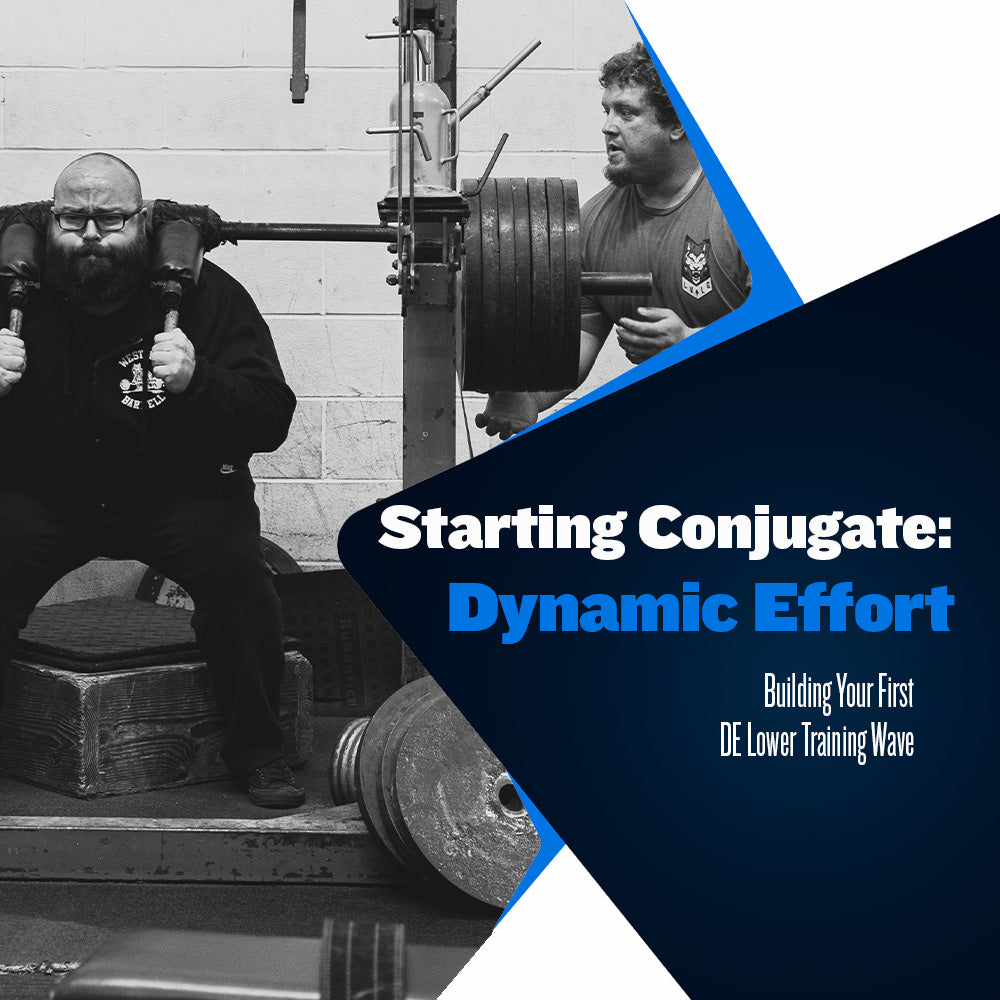Dynamic Effort: Building Your First DE Lower Wave
5 Comments

As we have mentioned, at Westside Barbell, we utilize the dynamic effort method every week to increase force production and improve an athlete’s ability to move powerfully. Aside from those benefits, dynamic effort training also provides an optimal level of volume between 70-85%, which will help raise absolute strength and muscle mass.
At Westside, we refer to our dynamic effort squat and deadlift training as DE lower day. A typical DE lower training day will include squats and deadlifts, with squats being the primary focus and deadlifts being performed as the main accessory exercise.
The first exercise of the day will usually be a box squat variation. Regarding variations, we create them using specialty barbells and different forms of accommodating resistance. We use specialty barbells, including a powerlifting squat bar, bow bar, safety squat bar, and the giant cambered bar. Most often, the accommodating resistance will be in the form of bands.
Essentially, these barbells and forms of accommodating resistance represent the tools you have at your disposal when constructing dynamic effort lower training waves.
What is a Training Wave?
A training wave is a short-term approach to strength-specific training that allows for more significant training optimization for the athlete compared to the average long-term phase approach.
At Westside, all training waves are programmed for three-week periods. This means that for your dynamic effort upper and lower body training, you will perpetually perform three-week training waves.
A short-term training wave is advantageous to the athlete because it offers a greater level of variation, increasing the amount of effective stimulus the athlete will experience while avoiding accommodation entirely.
Instead of waiting for the end of a long-term training phase to evaluate training feedback and plan for the next phase, we evaluate our dynamic effort training every three weeks and make adjustments to increase optimization.
Here is an example displaying the standard template for a DE Lower training day:
Week 1 - 12 x 2 @75% or 5 x 5 @70%
Week 2 - 10 x 2 @80% or 5 x 5 @75%
Week 3 - 6 x 2 @85% or 5 x 5 @80%
Bar Weight and Band Tension
One of the most frequent questions is how much weight should be on the barbell and how much should be in bands when setting up a dynamic effort exercise. For dynamic lower, here are how athletes should break down each of the above training percentages:
Week 1 - 75% = 50% barbell + 25% band or chain, 70% = 45% barbell + 25% band or chain
Week 2 - 80% = 55% barbell + 25% band or chain, 75% = 50% barbell + 25% band or chain
Week 3 - 85% = 60% barbell + 25% band or chain, 80% = 55% barbell + 25% band or chain
Your First Training Wave
If you are new to box squats or squatting with bands, it is recommended you take some time to learn how to utilize both properly. This should take the average athlete less than a training session; however, if it takes more time to learn, do not hesitate to continue.
Without proper form and execution, you cannot get the maximum benefits out of dynamic effort training. Once you have figured out how to box squat against band tension properly, you can begin week one of your training wave.
Here is how week one would look for an athlete with a 500lb max squat running a 12 x 2 wave:
Week One
Bar Weight = 250lbs
Band Tension = 125lbs
Total Weight = 375lbs
Athletes will perform box squats for 12 sets of 2 reps per set.
Week Two
Bar Weight = 275lbs
Band Tension = 125lbs
Total Weight = 400lbs
Athletes will perform box squats for 10 sets of 2 reps per set.
Week Three
Bar Weight = 300lbs
Band Tension = 125lbs
Total Weight = 425lbs
Athletes will perform box squats for 6 sets of 2 reps per set—end of wave.
What’s Next?
Once you have finished all three weeks, you will move on to your next three-week wave. Unless a new max squat PR has been established through your max effort lower training, you will continue to use the squat max you previously used to figure out your bar weight. What will change is the specialty barbell and the form of accommodating resistance used.
In the next article, we will go over how to transition to your next three-week training phase and how that is programmed when a new max effort squat has been established. Keep an eye out for that, and as always, visit the Westside Barbell blog for additional training information.
Sources:
Simmons, L. (2007). Westside Barbell Book of Methods. Westside Barbell.
Verkhoshansky, Y., & Siff, M. C. (2009). Supertraining. Verkhoshansky.




